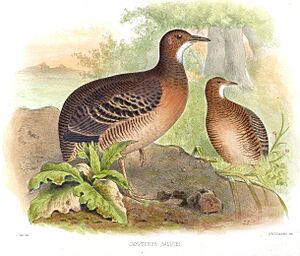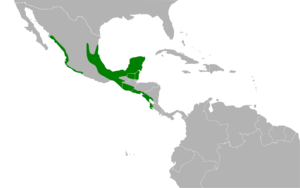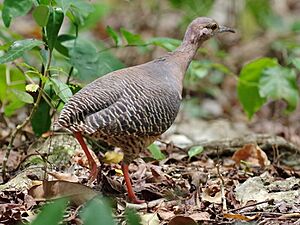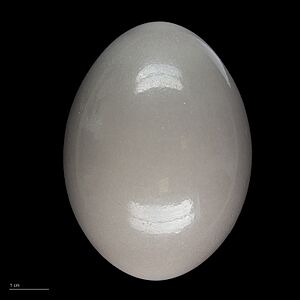Thicket tinamou facts for kids
Quick facts for kids Thicket tinamou |
|
|---|---|
 |
|
| Conservation status | |
| Scientific classification | |
| Genus: |
Crypturellus
|
| Species: |
cinnamomeus
|
| Subspecies | |
|
C. c. cinnamomeus |
|
 |
|
| Synonyms | |
|
Tinamus cinnamomeus |
|
The thicket tinamou (also called the rufescent tinamou) is a special bird found in the warm, wet forests of central Mexico. Its scientific name is Crypturellus cinnamomeus. It's a type of tinamou, a group of birds that are a bit like chickens but with some unique features.
Contents
About the Thicket Tinamou
All tinamous belong to the bird family called Tinamidae. They are also part of a larger group known as ratites. Other ratites include ostriches and emus, which cannot fly. However, tinamous are different because they can fly, even if they are not very strong flyers. Scientists believe that all ratites came from ancient flying birds, and tinamous are the closest living relatives to these prehistoric birds.
A scientist named René-Primevère Lesson first identified the thicket tinamou in 1842. He studied a bird from La Unión, El Salvador.
Different Types of Thicket Tinamous
The thicket tinamou has many different types, called subspecies. Each subspecies lives in a specific area:
- C. c. cinnamomeus: Found in coastal southeastern Mexico (like Chiapas), El Salvador, Guatemala, and Honduras.
- C. c. occidentalis: Lives on the western coast of Mexico, in states like Sinaloa and Jalisco.
- C. c. mexicanus: Found in coastal northeastern Mexico, including Tamaulipas and northern Veracruz.
- C. c. sallaei: Lives in southern Mexico, in states such as Puebla and Oaxaca.
- C. c. goldmani: Found in southeastern Mexico, on the Yucatan Peninsula, and in northern Belize.
- C. c. soconuscensis: Lives on the Pacific side of Chiapas and Oaxaca states in Mexico.
- C. c. vicinior: Found in the high lands of Chiapas State, Mexico, Guatemala, and western Honduras.
- C. c. delattrii: Lives in the Pacific lowlands of Nicaragua, in areas like Chinandega and León.
- C. c. praepes: Found in the lowlands of northwestern Costa Rica, in provinces like Guanacaste.
What's in a Name?
The scientific name Crypturellus comes from three Latin or Greek words. Kruptos (κρυπτός) means "covered" or "hidden." Oura means "tail." And ellus means "small" or "diminutive." So, Crypturellus means "small hidden tail," which describes how the tinamou's tail is often hard to see.
How to Spot a Thicket Tinamou
The thicket tinamou is about 27 to 29 centimeters (11 to 11.5 inches) long. It weighs around 440 grams (15.5 ounces). Its upper body is brown, with dark blackish stripes on its back, rump, and wings. Its belly is a lighter brown, with a cinnamon color on its chest. The lower belly is grayer, and the feathers under its tail are whitish with dark stripes.
Its head is brown, with a clear buff-colored stripe above its eye. It also has a distinct patch of feathers covering its ears. The bird's beak is brownish, and its legs are red.
Thicket Tinamou Behavior
The thicket tinamou makes a simple, repeated sound that goes "whoo-oo." Some people say it sounds like an old steam engine. These birds can be found alone, in pairs, or sometimes in family groups. Like most tinamous, they prefer to walk on the ground rather than fly.
What They Eat
Just like many other tinamous, the thicket tinamou enjoys eating different kinds of food. Their diet includes fruits, seeds, and small invertebrates (like insects and worms).
Reproduction and Life Cycle
The thicket tinamou builds its nest on the ground. They often place it next to raised tree roots for protection. A nest usually holds about three eggs, but sometimes they can have as many as seven. The eggs are very shiny and have a beautiful purple color. Sometimes, this species can even have babies with another type of tinamou called the slaty-breasted tinamou, creating hybrids.
Where Thicket Tinamous Live
This bird lives in a wide area, from Sinaloa (a coastal part of western Mexico) all the way down to Costa Rica. It also lives along the eastern coast of Mexico, from the United States border into Belize. In the southern parts of its home range, it can also be found in higher, mountainous areas.
Thicket Tinamou Habitat
The thicket tinamou likes to live in moist lowland forests. This includes gallery forests (forests along rivers), deciduous forests (where trees lose their leaves), and secondary forests (forests that have regrown after being cut down). They also live in shrublands and drier forests. They can be found at altitudes up to 1,850 meters (6,070 feet) above sea level.
Conservation Status
The IUCN (International Union for Conservation of Nature) has listed the thicket tinamou as a species of Least Concern. This means that its population is stable and not currently at risk. The area where this bird lives covers about 600,000 square kilometers (230,000 square miles).




